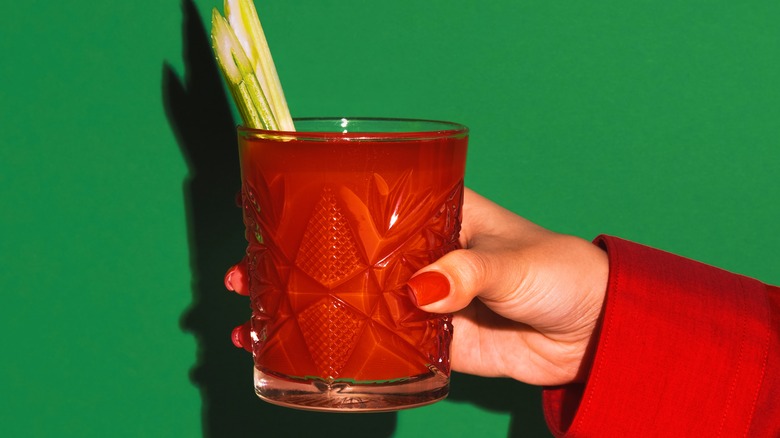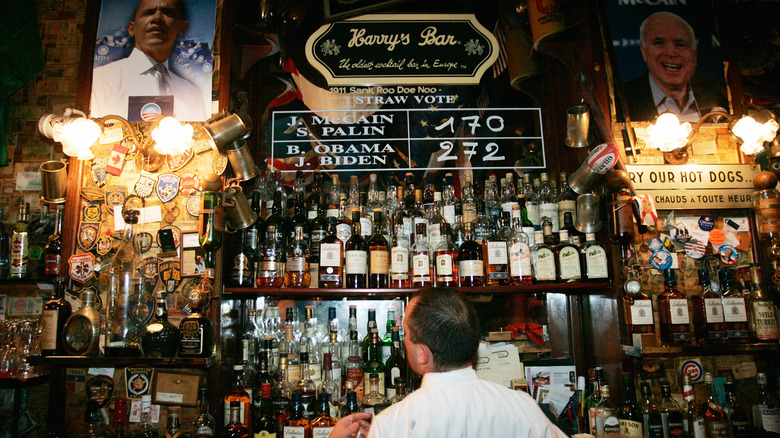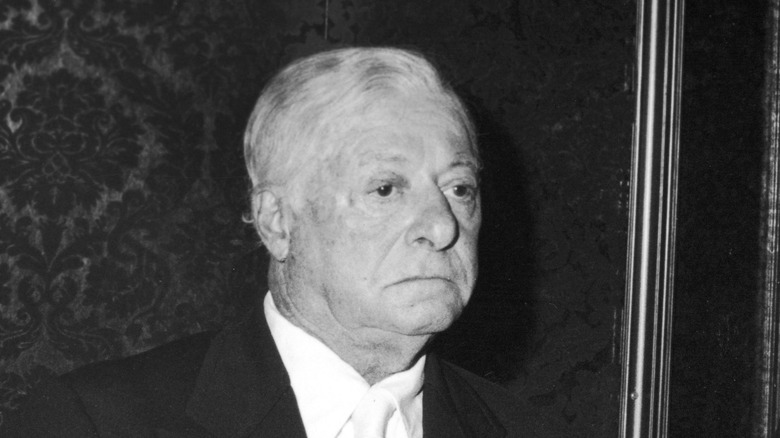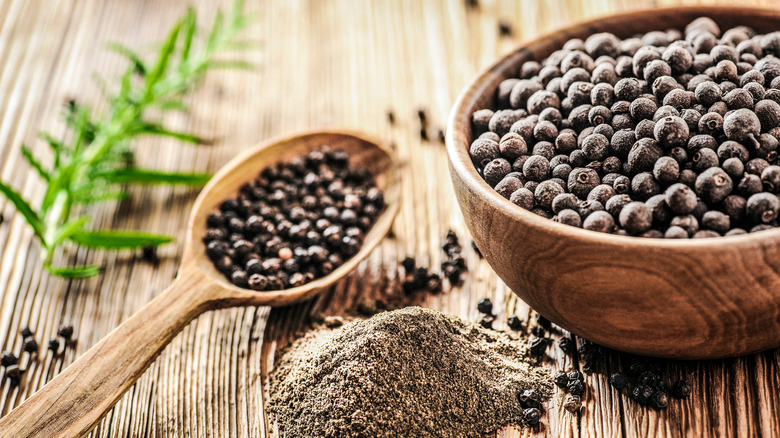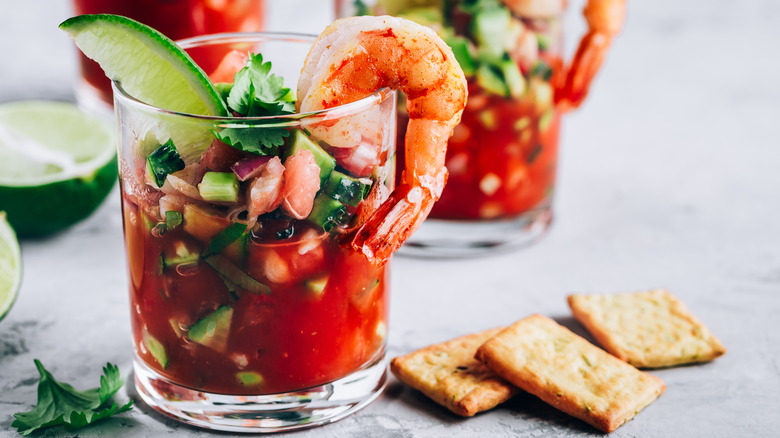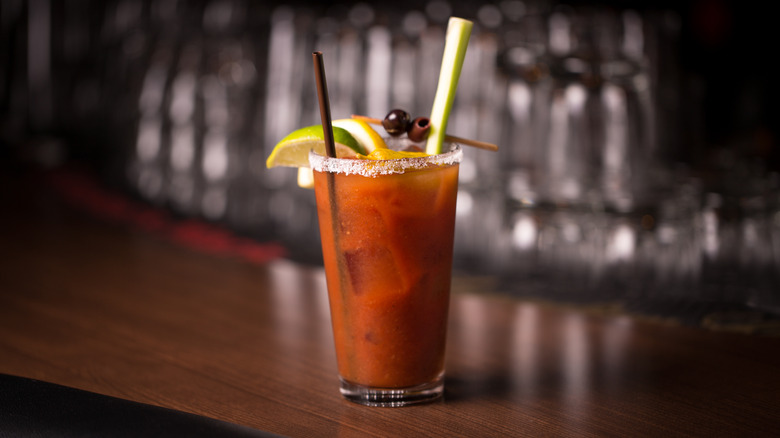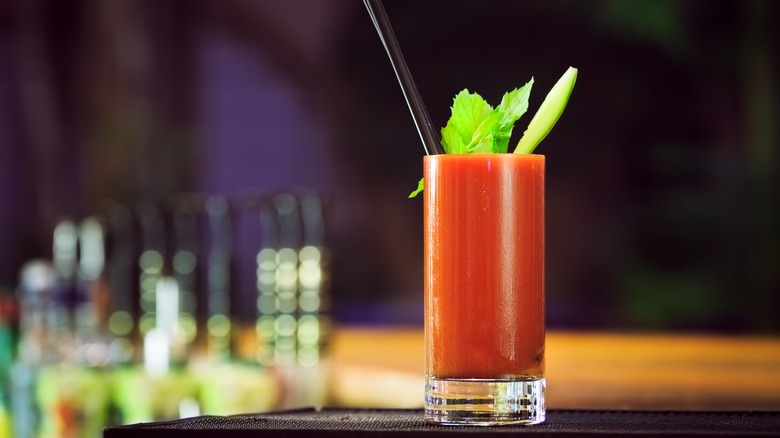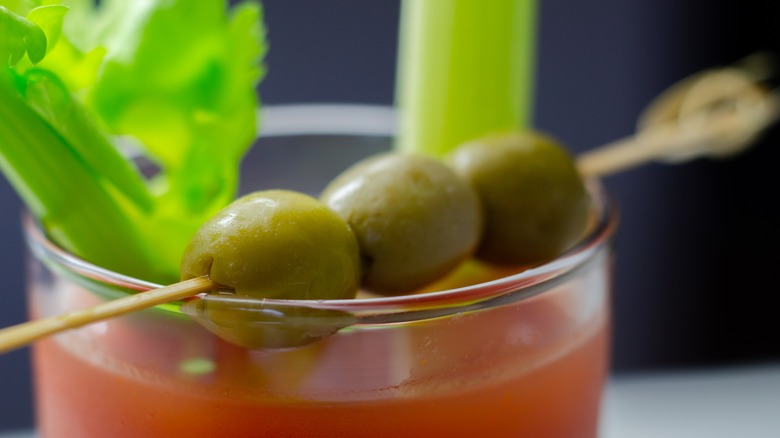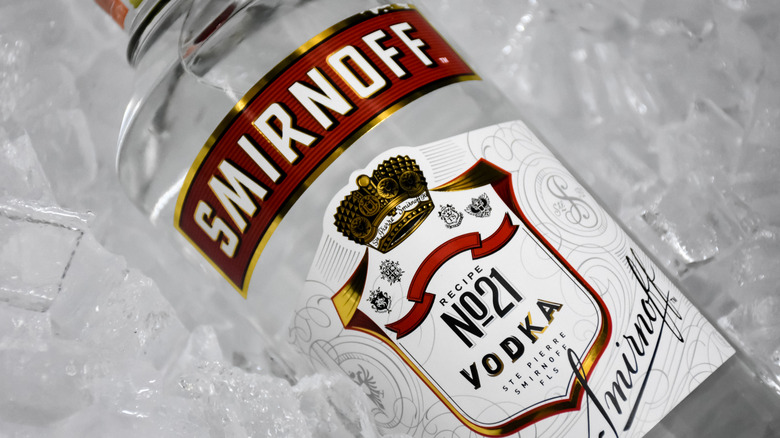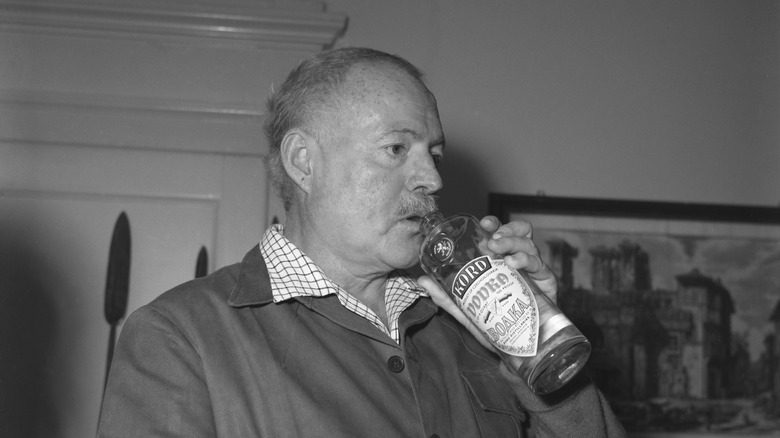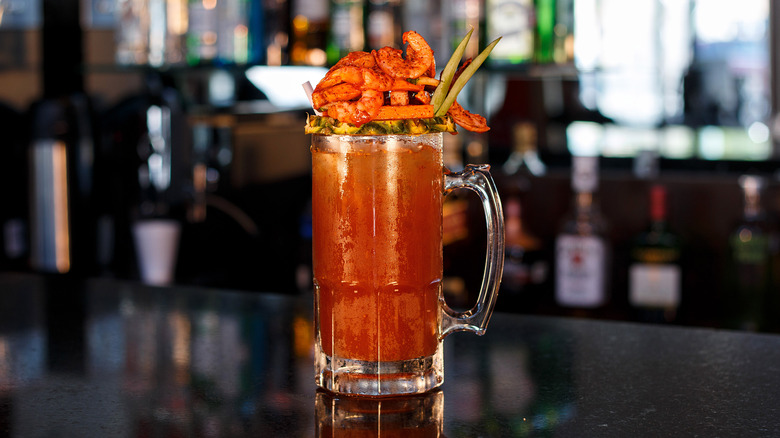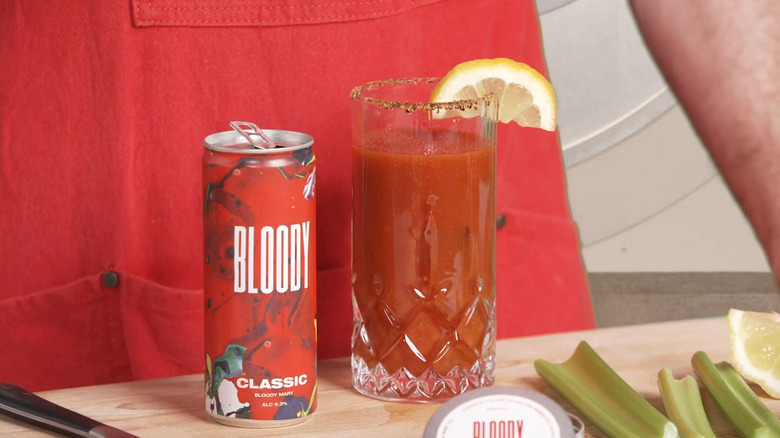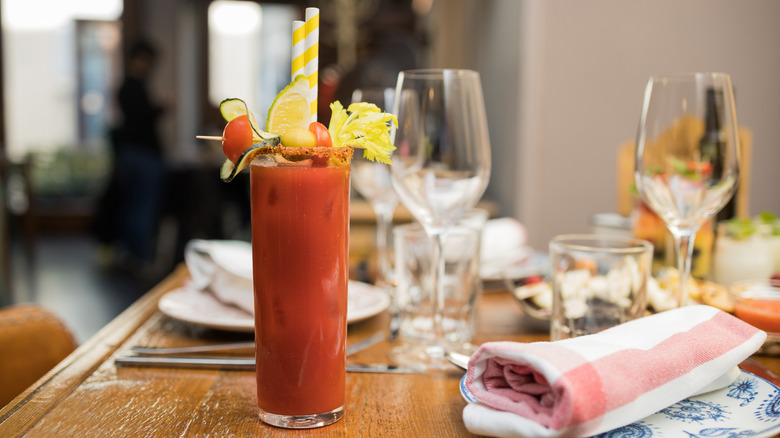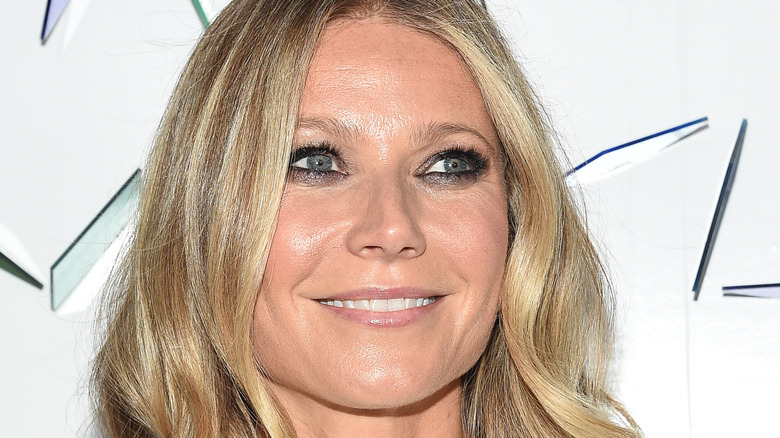The Untold Truth Of The Bloody Mary
Vodka and tomato juice do not sound like a combination that would give rise to a drinkable cocktail, let alone one that would establish itself as a classic. Yet, in the form of the Bloody Mary, they do just that. These two seemingly poorly matched ingredients, when mixed with a few spices and sauces, make one of the most beloved beverages in the world. Of course, the Bloody Mary is most celebrated as a hangover cure (per After Drink). However, a less frequently acknowledged aspect of the drink is its flexibility. Other cocktails, such as Negronis and old fashioneds, allow only a little room for mixologists to express themselves. Bloody Marys, on the other hand, are an entirely different story, as nearly all aspects of the beverage — from glass to garnish and everything in between — are alterable (via The Cocktail Society).
Despite the drink's flexibility, all too often the Bloody Mary is discounted as an antiquated eccentricity that — like an odd neighbor — we simply put up with. There is no denying the fact that the Bloody Mary is old — it is over 100, in fact — yet that doesn't mean that it isn't a cocktail for the contemporary day. Its unique taste, restorative abilities, and pop culture associations are still as valid now as they were in the 20th century. The only difference is that we now have over 100 years of incredible stories, history, and associations to dig into alongside our cocktail.
Fernand Petiot of Harry's New York Bar claimed to have invented the Bloody Mary
As with nearly every classic libation to be invented, the origins of the Bloody Mary are somewhat opaque. The most persuasive — and widely believed — claim is from a barman by the name of Fernand Petiot. Petiot worked in Paris at a bar whose fame and renown has only grown. Harry's New York Bar was the bar to visit for American expatriates in Paris during the earlier half of the 1900s, with many notable names frequenting the bar, including F. Scott Fitzgerald and Ernest Hemingway (via The BBC).
It was during the roaring '20s that Petiot claims to have invented the drink, originally mixing vodka with canned tomato juice and then experimenting with different flavorful additions until he found one that he liked (via Esquire). These were salt, black pepper, lemon, Worcestershire sauce, and spice in the form of cayenne pepper (via Washingtonian). Petiot's recipe is a testament to one of the great maxims surrounding the drink: The fewer the extra additions to a Bloody Mary, generally the better it tastes. As Max Venning, a respected mixologist, put it to iNews, "The best ones pack a punch but they don't need to be too hot, or have too much going on ... I like to keep mine simple. Overcomplicating drinks is when things can start going wrong."
One man hotly disputed Petiot's claim
As previously mentioned, the origins of cocktails are rarely straightforward, and the most powerful rebuttal of Fernand Petiot's claim came from George Jessel, an American actor, film producer, and songwriter (via IMDb). Jessel maintained for his whole life that it was he had been the one to invent the cocktail. His story behind the cocktail's invention was that he directed a bartender to make the drink on a whim after a hard night of partying (per Agalima). In what was a clever marketing ploy by both sides, Jessel and Smirnoff partnered together to release adverts asserting that Jessel invented the drink using Smirnoff vodka (via Ramshackle Pantry).
Despite the partnership with Smirnoff, Jessel's version of the story could not stand up to Petiot's. This is because Petiot — whether or not he created the cocktail — was undoubtedly the man who popularized it. First at Harry's in Paris and later at the St. Regis Hotel in New York, as noted by Imbibe magazine. Consequently, the Bloody Mary is seen as Petioit's cocktail and is most recognized as being invented by the man at Harry's in 1921 (per ABC News).
The name Bloody Mary could have many origins
To further complicate the history of this esteemed cocktail, the origin of its name, Bloody Mary, is also hotly debated. One of the most popular explanations is that the cocktail is named after Queen Mary I, an English monarch who earned the nickname Bloody Mary thanks to her violently enforced repeals of Protestantism (via History). Presumably the drink's crimson color, reminiscent of blood, was enough for patrons to make the association between cocktail and previous English monarch.
Many other theories abound, including that Fernand Petiot named the drink after a waitress who worked at the Bucket of Blood, a bar in Chicago (via Difford's Guide). Of course, George Jessel, the other claimant to the Bloody Mary throne, had his own origin story. In his version of events, he gave one of the first-ever Bloody Marys to his friend Mary Brown Warburton who proceeded to spill the drink down her white dress. Upon looking down, she supposedly stated, "Now, you can call me Bloody Mary, George!"
An early recipe actually used black pepper vodka
Nothing is as good as the original, and that holds true for the Bloody Mary as well. Though the secrets of the original recipe for the most part have been withheld from public record, recently some details came to light. In fact, the recipe made in the King Cole Bar at the St. Regis Hotel in New York looked to have combined two ingredients. According to Thrillist, the original King Cole Bar drink called for what they referred to as "liquid black pepper."
Though today, many people add vodka and a pinch of black pepper separately into a Bloody Mary, the original recipe mixed them together for a pretty potent taste. The bartender responsible, Fernand Petiot, is said to have infused black peppercorns into vodka for roughly a month-and-a-half before adding a few dashes of the concoction to the drink. What resulted was more heat than simply a pinch of freshly ground black pepper could provide.
There are many variations of the Bloody Mary
Any and all classic cocktails have given rise to a number of popular varieties. Negronis gave birth to white Negronis, and martinis led to the extremely popular espresso martinis. However, the sheer flexibility of the Bloody Mary marks it as perhaps the most-adapted cocktail in history. This is largely due to the Bloody Mary's one defining feature being not the inclusion of a particular spirit, but the use of tomato juice (via The Guardian). This allows mixologists a vast array of opportunities to come up with their own style.
With everything aside from tomato juice fair game, many mixologists choose to play around with spirits. Swap vodka for gin, and you have a cocktail called The Red Snapper, a botanically forward version of the Bloody Mary, also created by Fernand Petiot (per Sipsmith). The addition of mezcal or tequila will create a Bloody Maria (per Distiller), while a Ghost of Mary can be made with tomato consommé, imparting a lighter, fresher flavor (per Vogue). Spice wise, Bloody Marys will vary from bar to bar. The inclusion of celery salt continues to divide drinkers, with many loving its savory undertones (via The Guardian), whereas others — including the people behind the official cocktail recipe book of Harry's New York Bar — are vehemently against its use (via Washingtonian).
The Bloody Mary was the first popular savory cocktail
There is no denying the fact that Bloody Marys are unique. And while the drink is by no means the only savory cocktail nowadays, it can definitely lay claim as to being one of the first. It's a fact that has cemented the cocktail's position as a classic, as explained by mixologist Max Venning. He told iNews, "I think they've stayed relevant because they were the first properly savory cocktail. In that sense they're quite unusual — they really opened up the idea of savory drinks. They're a classic, even if they're not fashionable. They're a bit like a dad's barbecue in that everyone has their recipe, their style, and they always spark a conversation."
The notion that they are actually a drink is even up for debate sometimes, with many citing the cocktail as something in between food and beverage (via Chicago Tribune). Indeed, Bloody Marys may owe their popularity to the fifth taste, umami. As reported by Drink, Bloody Marys have long been seen as the standard bearer for liquid umami and a testament to the fifth taste's relevance behind the bar. Understanding how drinks can utilize umami is also becoming increasingly important as drinks rich in it gain popularity. Michele Mariotti, mixologist at 7 Tales, believes the growing presence of these drinks is "because now bartenders are shifting away from the traditional three main flavor categories, and umami has a lot to give as is not been explored in the past."
It's one of the most popular in-flight drinks
While you probably can't go one weekend without seeing a Bloody Mary on someone's table at breakfast or brunch, the other place Bloody Marys do quite well is in the air. According to The Spirits Business, scientists once thought that this specialty drink actually tasted stronger while on board a plane due to the increase in altitude that they theorized influenced taste buds. It gave them enough pause that they even conducted a study to find out just why Bloody Marys were the preferred drink of frequent fliers.
The true reason, they found out, was actually because people tended to prefer the savory flavors of the Bloody Mary that somehow tempers the noise inside the cabin. Apparently, those flying felt that a sweet drink with sugary flavors was harder to enjoy within the auditory chaos. Instead, they favored the umami notes that are present in this drink, thanks to ingredients like the tomato juice, Worcestershire sauce, and celery salt. Quite a pro tip for the next time you fly and forget the noise-canceling headphones!
It is a popular hangover cure
The Bloody Mary is first and foremost known as a hangover cure, and its ability to restore previously nauseous patrons to good health has ensured its enduring popularity. While the science on hangovers is not exactly conclusive (via Smithsonian Magazine), there are some theories on why Bloody Marys have come to be such a trusted savior from those stomach-churning, head-pounding mornings. As reported by Men's Journal, the peculiar ingredients found in Bloody Marys, such as tomato juice, contain compounds which have been shown to help people digest alcohol more quickly. And though vodka will not help your hangover in the long run, it will elevate some of the unpleasant systems you are experiencing in the moment, giving you the impression of being cured (per Healthline).
So frequently are Bloody Marys used in this hair-of-the-dog approach that the cocktail has been given its own official day in the calendar. National Bloody Mary Day falls on January 1 (via PrestigeHaus), a fitting date for one of the world's favorite hangover cures.
International trade and travel made the Bloody Mary possible
Regardless of whether the Bloody Mary was first invented in Paris or the United States, the cocktail undoubtedly has international trade and travel to thank for its creation. This is because the cocktail's two key ingredients — canned tomato juice and vodka — came from opposite sides of the globe. The Russian Revolution caused mass displacement of over 1 million Russians (via European studies blog). Many of these refugees fled into Europe bringing their customs and traditions — including the distilling and drinking of vodka — with them (via Esquire). The flavorless spirit took off rapidly in Paris, but didn't perform so well in the United States, only rising to prominence during the '50s thanks to a prolonged marketing campaign that featured new cocktails like the Moscow Mule (per Atlas Obscura).
Tomato juice also became popular in the early part of the 20th century after a chef supposedly invented the drink at French Lick Springs Hotel when he ran out of oranges (per Historic Hotels). The drink was a hit and was soon being served throughout prohibition America under the name tomato juice cocktail (via Silver Circle Distillery). With eyes on a global market, tomato juice was soon canned and exported, arriving in Europe and giving Fernand Petiot the opportunity to combine it with the newly popularized vodka.
Ernest Hemingway was closely associated with the Bloody Mary
Wherever notable writer Ernest Hemingway went, a drinking establishment seemed to be catapulted from insignificance to fame. There are two world famous bars Hemingway frequented in Cuba, El Floridita and La Bodeguita del Medio, as well as many in the United States (including Sloppy Joe's in Key West, Florida) and a plethora across Europe. Yet, perhaps the eminent author's most well-known haunt was Harry's New York Bar in Paris. There are many stories of Hemingway and the bar where the Bloody Mary was born, one even involving a welterweight boxing world champion, a lion, and the famed author (via Washingtonian). While some of these tales may be a smidgen removed from the truth, it is widely accepted that Hemingway was one of the main advocates for the Bloody Mary. In classic Hemingway style, he even claimed to have popularized the cocktail in Hong Kong in 1941 (via Esquire).
Of course, Hemingway was a drinker of some renown, known for his ability to put away an absurd number of daiquiris. His penchant for strong drinks perhaps typified by his own cocktail, Death in the Afternoon: a shot of absinthe mixed with ice cold champagne (via Liquor). Despite his taste for stronger drinks, Hemingway still enjoyed Bloody Marys enough that he wrote a recipe of his own. By following the recipe, you will end up with a jug of the cocktail, as he deemed drinking any lesser amount not worthwhile.
Bloody Marys can be garnished with nearly anything
As with nearly every aspect of the Bloody Mary, the garnish can be altered to suit one's preference. A classic garnish for the cocktail is a celery stick, a flavor that is frequently included in the body of the cocktail via the use of celery salt. However, the use of celery as a garnish provides not only taste and texture but acts as an aromatic balancer and palate cleanser (via McClain Cellars).
Often called "a meal in a glass" (per Chicago Tribune), the umami-filled Bloody Mary can hold garnishes of a heartier fare. This can include bacon, shrimps, clams, and olives — or a mixture of them all. Indeed, many bars see the Bloody Mary as a vehicle for outrageous, headline-grabbing garnishes. Over the years, we have seen Bloody Marys with a weight equal to that of a small dog (via Metro News), while sliders on skewers have become an increasingly popular feature (per The Daily Mail). Old Towne's Alibi, a pub in Petersburg, Virginia, has done one better. Their enormous Bloody Mary — which is topped with a whole rotisserie chicken, among other things — is a terrifying food challenge, one which only a single person has successfully completed in under an hour (per The Progress Index). Fortunately, all these failed attempts are not completely in vain, as all proceeds of the challenge go to charity.
There are now a number of ways to easily enjoy a Bloody Mary at home
While far from the most complicated cocktail to make, Bloody Marys still require a few ingredients and some skill to get right. In an attempt to negate some of these issues and ensure the public can enjoy a reliable, delicious Bloody Mary with little hassle, some companies have started to produce a range of products that facilitate the cocktail-making process or bypass it altogether.
The most prominent of these is Bloody Drinks, which has created a canned version of the cocktail that features a surprise inclusion: amontillado sherry (per City A.M.). The response to canned Bloody Marys has been positive. As explained by co-founder Will Best (via The Grocer), "Once [customers] do take the plunge and try us, they tend to stick around — according to one of our grocery accounts we've got the highest customer loyalty in the category, and we're slowly translating that into a real community of Bloody Drinks lovers."
Other businesses look to provide the means for customers to make their own exceptional Bloody Marys by providing premixed spice blends, such as Dirty Sue's Bloody Mary spice mix. This blend, which has been featured in The New York Times, comes from a cocktail-minded company that got its start making bottled olive juice for dirty martinis. Using the blend is simple; you need only to mix some of it with vodka and tomato juice.
Bloody Marys have long been associated with brunch
There are a few cocktails associated with the enduring gastronomic phenomenon that is brunch – namely bellinis, mimosas, and Bloody Marys. Mimosas are perhaps the most popular of the three (via Make Me a Cocktail), especially in the contemporary world where bottomless brunches are king. This is because mimosas are simple to make and can be easily — and cheaply — embellished (per The Guardian). Yet, Bloody Marys are popular with the bottomless brunch crowd too. This enduring regard for a midmorning Mary is built upon the cocktail's long history as a restorative morning beverage (per After Drink).
Our pigeonholing of Bloody Marys as a morning or — at the latest — an early afternoon drink does not suit all. Indeed, there are those who are pushing back at the notion of the Bloody Mary as a brunch drink, even though this is what has ensured the cocktail's enduring legacy. As reported by Vine Pair, many mixologists and restaurant owners are keen to experiment with the cocktail, serving it alongside evening meals, such as spaghetti or steak, and even as a nightcap.
The cocktail has ties to much of popular culture
A cocktail that has been around as long as the Bloody Mary has is sure to have made some sort of impression in pop culture. The impact of the Bloody Mary, though pronounced in the early 20th century, is not limited to the annals of history. Rather, the cocktail continues to influence popular culture today with prominent celebrities, such as Gwyneth Paltrow, being vocal about their love for them (per The Daily Mail).
The Bloody Mary was also prominent in popular culture in 2013 when the film adaptation of F. Scott Fitzgerald's classic novel "The Great Gatsby" was released. Despite the film itself receiving mixed reviews (via The Guardian), the Bloody Mary reached new audiences thanks to the sudden public interest in the so-called roaring '20s. Many mixologists welcomed the attention this era and its drinks received. Joe Mitchell, part of the management team at the Leeds bar Revolution Electric Press, said (per The Daily Mail), "The era of cocktail glamour is most certainly coming back, people are becoming more educated on spirits and so we're constantly updating our own recipes to ensure we're ahead of the new trends."
